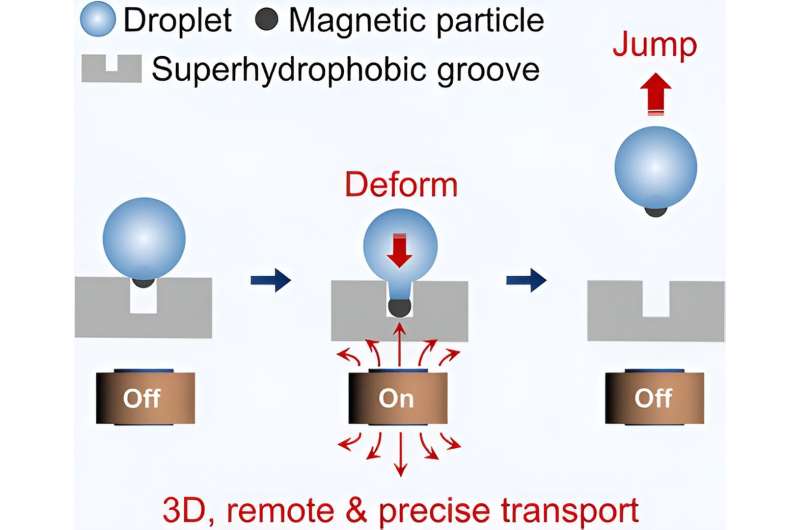
A small combined team of material scientists from Sun Yat-sen University and Dalian University of Technology, both in China, has found that it is possible to make a single drop of water hop in desired ways by putting a magnetic particle inside of it and turning an electromagnet on and off. The research published in the journal ACS Nano.
The research team was investigating on-demand droplet transportation as part of a larger effort. To learn more about the possibility of inciting drops of liquid, in this case water, to move in desired ways, they set up several structures.
The researchers carved small grooves on a flat surface. The surface was then covered with a varnish known to prevent water absorption, thereby allowing droplets to form when splashed onto the surface. Once the droplets formed, the team placed a tiny piece of metal into each drop, where it was held in place by the forces that held the bubble shape. The entire surface was then placed over a set of electromagnets.
The research team found that when the electromagnet was turned on, it pulled the bottom portion of a drop down into the groove below, stretching it. Turning off the electromagnet resulted in a sudden removal of the downward force, allowing the drop to snap back to its original shape like a rubber band. But because of the amount of energy held in the drop, the returning snap pushed the drop into the air for a moment before rebounding.
Using this hopping technique, the researchers found they could cause a single drop to climb tiny stairs, or to move over obstacles. They even tried using it to fill the space between two wires, causing a light to flash on and off.
The technique could prove useful for transporting or mixing chemicals—or perhaps for a drug delivery system. The researchers even envision scaling it down and using it to create lab-on-a-chip applications.
More information:
Yusheng Huang et al, Magnetic-Actuated Jumping of Droplets on Superhydrophobic Grooved Surfaces: A Versatile Strategy for Three-Dimensional Droplet Transportation, ACS Nano (2024). DOI: 10.1021/acsnano.3c11197
Journal information:ACS Nano

READ MORE
What Can Dancing Cockatoos Teach Us About Ourselves?
A sulphur-crested cockatoo bows down at the Madrid Zoo Aquarium. The birds have been seen [...]
How to Pack Wheel Bearings
One of the most important things you can do to make sure that you get [...]
Annual Percentage Rate (APR): What It Means and How It Works
What Is Annual Percentage Rate (APR)? Annual percentage rate (APR) refers to the yearly interest [...]
Microbially produced fibers: Stronger than steel, tougher than Kevlar
The 128-repeat proteins resulted in a fiber with gigapascal strength which is stronger than common [...]
Will it hurt to spray electrical contact cleaner in an ignition?
Using a spraying electrical contact cleaner in an ignition should not hurt your car. wera [...]
The Meteorite That Killed the Dinosaurs May Have Also Triggered Underwater Volcanoes
Seismic shockwaves after a meteorite’s collision could affect systems all over the planet. solarseven/Shutterstock.com The [...]
The Death Of A Pet Should Be Taken More Seriously By Therapists
For some reason, the loss of a pet is often dismissed as a cause of [...]
Does Bug Spray Expire?
Your bug spray from last summer? It’s probably still good. RealPeopleGroup/Getty Images Key Takeaways Bug [...]